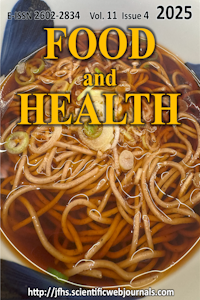Abstract
References
- Albayrak, S., Aksoy, A., Sagdic, O., & Albayrak, S. (2012). Antioxidant and antimicrobial activities of different extracts of some medicinal herbs consumed as tea and spices in Turkey. Journal of Food Biochemistry, 36(5), 547-554. https://doi.org/10.1111/j.1745-4514.2011.00568.x
- Armbruster, D.A., & Pry, T. (2008). Limit of blank, limit of detection and limit of quantitation. The Clinical Biochemist Reviews, 29(Suppl 1), S49-S52.
- Bağcı, Y., Savran, A., & Dural, H. (2006). Pozantı (Adana) ve çevresindeki bazı bitkilerin yerel adları ve etnobotanik özellikleri. Selçuk Üniversitesi Fen Fakültesi Fen Dergisi, 2(27), 77-82.
- Balkan, C.E., Karamese, M., Celebi, D., Aydogdu, S., Dicle, Y., & Calik, Z. (2016). The determination of the antibacterial activities of rose, thyme, centaury and ozone oils against some pathogenic microorganisms. Kafkas Journal of Medical Sciences, 6(1), 18-22. https://doi.org/10.5505/kjms.2016.87587
- Ballester-Costa, C., Sendra, E., Fernández-López, J., Pérez-Álvarez, J.A., & Viuda- Martos, M. (2013). Chemical composition and in vitro antibacterial properties of essential oils of four Thymus species from organic growth. Industrial Crops and Products, 50, 304-311. https://doi.org/10.1016/j.indcrop.2013.07.052
- Bayrak Özbucak, T., Ergen Akçin, Ö., & Ertürk, Ö. (2013). The change in ecological, anatomical and antimicrobiological properties of the medicinal plant Tilia rubra dc. subsp. Caucasica (rupr.) v. engler along an elevational gradient. Pakistan Journal of Botany, 45(5), 1735-1742.
- Benli, M., & Yiğit, N. (2005). Ülkemizde yaygın kulla-nımı olan kekik (Thymus vulgaris) bitkisinin antimikrobiyal aktivitesi. Orlab On-Line Mikrobiyoloji Dergisi, 3(8), 1-8.
- Benzie, I.F.F., & Strain, J.J. (1999). Ferric reducing antioxidant power assay: Direct measure of total antioxidant activity of biological fluids and modified version for simultaneous measurement of total antioxidant power and ascorbic acid concentration. Methods in Enzymology, 299, 15-27. https://doi.org/10.1016/S0076-6879(99)99005-5
- Can, N., & Duraklı Velioğlu, S. (2018). Bitki çaylarında mikrobiyal kalite ve mikotoksin varlığı. Erzincan University Journal of Science and Technology, 11(3), 362-380. https://doi.org/10.18185/erzifbed.413371
- Dorman, H.J.D., & Deans, S.G. (2000). Antimicrobial agents from plants: antibacterial activity of plant volatile oils. Journal of Applied Microbiology, 88(2), 308-316. https://doi.org/10.1046/j.1365-2672.2000.00969.x
- Elhussein, E.A.A., Kurtulbaş, E., Bilgin, M., Birteksöz Tan, A.S., Hacıoğlu, M., & Şahin, S. (2018). Screening of the most consumed beverages and spices for their bioactive non-nutrient contents. Journal of Food Measurement and Characterization, 12, 2289-2301. https://doi.org/10.1007/s11694-018-9846-9
- Ilyasoğlu, H., & Arpa Zemzemoğlu, T. E. (2023). Effect of brewing conditions on sensorial and antioxidant properties of linden tea. Journal of Culinary Science & Technology, 21(4), 546-557. https://doi.org/10.1080/15428052.2021.1972886
- Jiménez-Zamora, A., Delgado-Andrade, C., & Rufián-Henares, J.A. (2016). Antioxidant capacity, total phenols and color profile during the storage of selected plants used for infusion. Food Chemistry, 199, 339-346. https://doi.org/10.1016/j.foodchem.2015.12.019
- Kasapoğlu, C. (2015). Püskürtmeli kurutucu ile çözünür ıhlamur çayı üretimi. Yüksek Lisans Tezi, İstanbul Aydın Üniversitesi, Fen Bilimleri Enstitüsü, Gıda Mühendisliği Anabilim Dalı, İstanbul.
- Kiselova, Y., Ivanova, D., Chervenkov, T., Gerova, D., Galunska, B., & Yankova, T. (2006). Correlation between the in vitro antioxidant activity and polyphenol content of aqueous extracts from Bulgarian herbs. Phytotherapy Research, 20(11), 961-965. https://doi.org/10.1002/ptr.1985
- Lisin, G., Safiyev, S., & Craker, L.E. (1999). Antimicrobial activity of some essential oils. ISHS Acta Horticulturae, 501, 283-287. https://doi.org/10.17660/ActaHortic.1999.501.45
- Marino, M., Bersani, C., & Comi, G. (1999). Antimicrobial activity of the essential oils of Thymus vulgaris L. measured using a bioimpedometric method. Journal of Food Protection, 62(9), 1017-1023. https://doi.org/10.4315/0362-028X-62.9.1017
- Nalbantbasi, Z., & Golcu, A. (2009). Kahramanmaras yöresine ait sifalı bitkilerin antimikrobiyal aktiviteleri. KSÜ Doğa Bilimleri Dergisi, 12(2), 1-8.
- Onbaşlı, D., & Dal, A. (2020). Türk Farmakopesindeki bazı tıbbi bitkilerin önemli farmakolojik gruplara göre incelenmesi. ERÜ Sağlık Bilimleri Fakültesi Dergisi, 7(1), 22-36.
- Prasanth Reddy, V., Ravi Vital, K., Varsha, P.V., & Satyam, S. (2014). Review on Thymus vulgaris traditional uses and pharmacological properties. Medicinal & Aromatic Plants, 3(4), 167. https://doi.org/10.4172/2167-0412.1000164
- Semerci, A.B., İnceçayır, D., Mammadova, V., Hoş, A., & Tunç, K. (2020). Antimicrobial activities of Allium staticiforme and Allium subhirsutum. A Journal of the Bangladesh Pharmacological Society, 15(1),19-23. https://doi.org/10.3329/bjp.v15i1.42373
- Sinan, K.I., Mahomoodally, M.F., Eyupoglu, O.E., Etienne, O. K., Sadeer, N.B., Ak, G., et al. (2021). HPLC-FRAP methodology and biological activities of different stem bark extracts of Cajanus cajan (L.) Millsp. Journal of Pharmaceutical and Biomedical Analysis, 192, 113678. https://doi.org/10.1016/j.jpba.2020.113678
- Tunç, K., Konca, T., & Hoş, A. (2013). Punica granatum Linn. (nar) bitkisinin antibakteriyel etkisinin araştırılması. Sakarya University Journal of Science, 17(2), 167-172. https://doi.org/10.5505/saufbe.2013.76598
- Ulusoy, A., & Şeker, M. (2013). Türkiye’de Değişen Çay Tüketim Alışkanlıkları Projesi, Trabzon Ticaret Borsası. Yıldız, A., Boşgelmez, İ.İ., & Süzen, H.S. (2022). Ihlamur çaylarının element düzeylerinin toksikolojik yönden değerlendirilmesi. Adnan Menderes Üniversitesi Sağlık Bilimleri Fakültesi Dergisi, 6(1), 149-165. https://doi.org/10.46237/amusbfd.956484
The antibacterial and antioxidant activity of the tea bag and the bulk of herbal tea: Which one is more?
Abstract
This study aimed to compare the antibacterial (using the disc diffusion method) and antioxidant (using the FRAP method) properties of tea bag herbal tea and bulk herbal tea of linden and thyme against Streptococcus mutans, Escherichia coli, Enterococcus faecalis, Staphylococcus aureus, and Staphylococcus epidermidis. It has been observed that the antibacterial activity of bulk herbal tea of linden is higher than that of tea bags of herbal tea, and even the tea bags of herbal tea have no antibacterial effect on the test microorganisms except S. aureus. However, when tea bags of herbal tea and bulk herbal tea of linden were analysed in terms of antioxidant properties, it was determined that the antioxidant activity of tea bags of herbal tea was higher than that of bulk herbal tea. Analyses of thyme extract showed that the antibacterial activity of bulk herbal tea was relatively higher than that of tea bags of herbal tea. Considering the antibacterial activity of the bulk and tea bag form of thyme herbal tea of the same brand, the bulk herbal tea showed higher antibacterial activity than the tea bag of herbal tea, and even the tea bag of herbal tea had no antibacterial effect on the test microorganisms except S. aureus and S. epidermidis.
Ethical Statement
The authors declare that this study does not involve experiments with human or animal subjects, and therefore, ethics committee approval is not required.
References
- Albayrak, S., Aksoy, A., Sagdic, O., & Albayrak, S. (2012). Antioxidant and antimicrobial activities of different extracts of some medicinal herbs consumed as tea and spices in Turkey. Journal of Food Biochemistry, 36(5), 547-554. https://doi.org/10.1111/j.1745-4514.2011.00568.x
- Armbruster, D.A., & Pry, T. (2008). Limit of blank, limit of detection and limit of quantitation. The Clinical Biochemist Reviews, 29(Suppl 1), S49-S52.
- Bağcı, Y., Savran, A., & Dural, H. (2006). Pozantı (Adana) ve çevresindeki bazı bitkilerin yerel adları ve etnobotanik özellikleri. Selçuk Üniversitesi Fen Fakültesi Fen Dergisi, 2(27), 77-82.
- Balkan, C.E., Karamese, M., Celebi, D., Aydogdu, S., Dicle, Y., & Calik, Z. (2016). The determination of the antibacterial activities of rose, thyme, centaury and ozone oils against some pathogenic microorganisms. Kafkas Journal of Medical Sciences, 6(1), 18-22. https://doi.org/10.5505/kjms.2016.87587
- Ballester-Costa, C., Sendra, E., Fernández-López, J., Pérez-Álvarez, J.A., & Viuda- Martos, M. (2013). Chemical composition and in vitro antibacterial properties of essential oils of four Thymus species from organic growth. Industrial Crops and Products, 50, 304-311. https://doi.org/10.1016/j.indcrop.2013.07.052
- Bayrak Özbucak, T., Ergen Akçin, Ö., & Ertürk, Ö. (2013). The change in ecological, anatomical and antimicrobiological properties of the medicinal plant Tilia rubra dc. subsp. Caucasica (rupr.) v. engler along an elevational gradient. Pakistan Journal of Botany, 45(5), 1735-1742.
- Benli, M., & Yiğit, N. (2005). Ülkemizde yaygın kulla-nımı olan kekik (Thymus vulgaris) bitkisinin antimikrobiyal aktivitesi. Orlab On-Line Mikrobiyoloji Dergisi, 3(8), 1-8.
- Benzie, I.F.F., & Strain, J.J. (1999). Ferric reducing antioxidant power assay: Direct measure of total antioxidant activity of biological fluids and modified version for simultaneous measurement of total antioxidant power and ascorbic acid concentration. Methods in Enzymology, 299, 15-27. https://doi.org/10.1016/S0076-6879(99)99005-5
- Can, N., & Duraklı Velioğlu, S. (2018). Bitki çaylarında mikrobiyal kalite ve mikotoksin varlığı. Erzincan University Journal of Science and Technology, 11(3), 362-380. https://doi.org/10.18185/erzifbed.413371
- Dorman, H.J.D., & Deans, S.G. (2000). Antimicrobial agents from plants: antibacterial activity of plant volatile oils. Journal of Applied Microbiology, 88(2), 308-316. https://doi.org/10.1046/j.1365-2672.2000.00969.x
- Elhussein, E.A.A., Kurtulbaş, E., Bilgin, M., Birteksöz Tan, A.S., Hacıoğlu, M., & Şahin, S. (2018). Screening of the most consumed beverages and spices for their bioactive non-nutrient contents. Journal of Food Measurement and Characterization, 12, 2289-2301. https://doi.org/10.1007/s11694-018-9846-9
- Ilyasoğlu, H., & Arpa Zemzemoğlu, T. E. (2023). Effect of brewing conditions on sensorial and antioxidant properties of linden tea. Journal of Culinary Science & Technology, 21(4), 546-557. https://doi.org/10.1080/15428052.2021.1972886
- Jiménez-Zamora, A., Delgado-Andrade, C., & Rufián-Henares, J.A. (2016). Antioxidant capacity, total phenols and color profile during the storage of selected plants used for infusion. Food Chemistry, 199, 339-346. https://doi.org/10.1016/j.foodchem.2015.12.019
- Kasapoğlu, C. (2015). Püskürtmeli kurutucu ile çözünür ıhlamur çayı üretimi. Yüksek Lisans Tezi, İstanbul Aydın Üniversitesi, Fen Bilimleri Enstitüsü, Gıda Mühendisliği Anabilim Dalı, İstanbul.
- Kiselova, Y., Ivanova, D., Chervenkov, T., Gerova, D., Galunska, B., & Yankova, T. (2006). Correlation between the in vitro antioxidant activity and polyphenol content of aqueous extracts from Bulgarian herbs. Phytotherapy Research, 20(11), 961-965. https://doi.org/10.1002/ptr.1985
- Lisin, G., Safiyev, S., & Craker, L.E. (1999). Antimicrobial activity of some essential oils. ISHS Acta Horticulturae, 501, 283-287. https://doi.org/10.17660/ActaHortic.1999.501.45
- Marino, M., Bersani, C., & Comi, G. (1999). Antimicrobial activity of the essential oils of Thymus vulgaris L. measured using a bioimpedometric method. Journal of Food Protection, 62(9), 1017-1023. https://doi.org/10.4315/0362-028X-62.9.1017
- Nalbantbasi, Z., & Golcu, A. (2009). Kahramanmaras yöresine ait sifalı bitkilerin antimikrobiyal aktiviteleri. KSÜ Doğa Bilimleri Dergisi, 12(2), 1-8.
- Onbaşlı, D., & Dal, A. (2020). Türk Farmakopesindeki bazı tıbbi bitkilerin önemli farmakolojik gruplara göre incelenmesi. ERÜ Sağlık Bilimleri Fakültesi Dergisi, 7(1), 22-36.
- Prasanth Reddy, V., Ravi Vital, K., Varsha, P.V., & Satyam, S. (2014). Review on Thymus vulgaris traditional uses and pharmacological properties. Medicinal & Aromatic Plants, 3(4), 167. https://doi.org/10.4172/2167-0412.1000164
- Semerci, A.B., İnceçayır, D., Mammadova, V., Hoş, A., & Tunç, K. (2020). Antimicrobial activities of Allium staticiforme and Allium subhirsutum. A Journal of the Bangladesh Pharmacological Society, 15(1),19-23. https://doi.org/10.3329/bjp.v15i1.42373
- Sinan, K.I., Mahomoodally, M.F., Eyupoglu, O.E., Etienne, O. K., Sadeer, N.B., Ak, G., et al. (2021). HPLC-FRAP methodology and biological activities of different stem bark extracts of Cajanus cajan (L.) Millsp. Journal of Pharmaceutical and Biomedical Analysis, 192, 113678. https://doi.org/10.1016/j.jpba.2020.113678
- Tunç, K., Konca, T., & Hoş, A. (2013). Punica granatum Linn. (nar) bitkisinin antibakteriyel etkisinin araştırılması. Sakarya University Journal of Science, 17(2), 167-172. https://doi.org/10.5505/saufbe.2013.76598
- Ulusoy, A., & Şeker, M. (2013). Türkiye’de Değişen Çay Tüketim Alışkanlıkları Projesi, Trabzon Ticaret Borsası. Yıldız, A., Boşgelmez, İ.İ., & Süzen, H.S. (2022). Ihlamur çaylarının element düzeylerinin toksikolojik yönden değerlendirilmesi. Adnan Menderes Üniversitesi Sağlık Bilimleri Fakültesi Dergisi, 6(1), 149-165. https://doi.org/10.46237/amusbfd.956484
Details
| Primary Language | English |
|---|---|
| Subjects | Food Packaging, Preservation and Processing, Food Microbiology |
| Journal Section | Research Article |
| Authors | |
| Early Pub Date | September 30, 2025 |
| Publication Date | October 2, 2025 |
| Submission Date | March 10, 2025 |
| Acceptance Date | June 16, 2025 |
| Published in Issue | Year 2025 Volume: 11 Issue: 4 |
Journal is licensed under a
CreativeCommons Attribtion-ShareAlike 4.0 International Licence 


Diamond Open Access refers to a scholarly publication model in which journals and platforms do not charge fees to either authors or readers.
Open Access Statement:
This is an open access journal which means that all content is freely available without charge to the user or his/her institution. Users are allowed to read, download, copy, distribute, print, search, or link to the full texts of the articles, or use them for any other lawful purpose, without asking prior permission from the publisher or the author. This is in accordance with the BOAI definition of open access.
Archiving Policy:
Archiving is done according to ULAKBİM "DergiPark" publication policy (LOCKSS).

